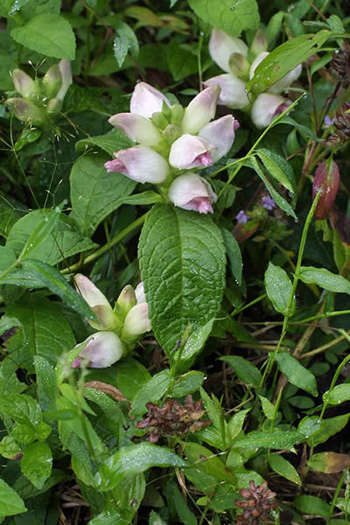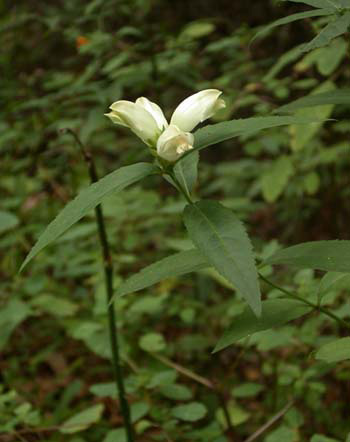Contents:
Common Names | Parts Usually Used | Plant(s) & Culture | Where Found | Medicinal Properties
Uses | Formulas or Dosages | Bibliography
Scientific Names

- Chelone glabra L.
- Scrophulariaceae
- Figwort family
Common Names
- Bitter herb
- Fishmouth
- Turtlebloom
- Turtlehead
- Salt-rheum weed
- Shell flower
- Snakehead
Parts Usually Used
Leaves
Back to Top
Description of Plant(s) and Culture

Balmony is an herbaceous perennial plant; its simple, erect, square stem reaches
Back to Top
Where Found
Found in wet ground from Newfoundland to Florida and westward to Minnesota, Kansas, and Texas.
Back to Top
Medicinal Properties
Anthelmintic, antibilious, aperient, cholagogue, stimulant, tonic
Back to Top
Uses
Good for weak stomachs and indigestion, general debility, constipation, and torpid (sluggish) liver. It stimulates appetite, fever, jaundice, expels worms, and in small doses is a good tonic during convalescence. Externally, it is used for sores, painful ulcers, herpes,inflamed breasts, and eczema. The ointment relieves itching and irritation of piles.
Back to Top
Formulas or Dosages
This herb may be difficult to obtain.
Infusion: use
Tincture: take
Back to Top
Bibliography
![]() American Folk Medicine
American Folk Medicine, by Clarence Meyer, Meyerbooks, publisher, PO Box 427, Glenwood, Illinois 60425, 1973
![]() Back to Eden
Back to Eden, by Jethro Kloss; Back to Eden Publishing Co., Loma Linda, CA 92354, Original copyright 1939, revised edition 1994
![]() Eastern/Central Medicinal Plants
Eastern/Central Medicinal Plants, by Steven Foster and James A. Duke., Houghton Mifflin Company, 215 Park Avenue South, New York, NY 10000
![]() Indian Herbalogy of North America
Indian Herbalogy of North America, by Alma R. Hutchens, Shambala Publications, Inc., Horticultural Hall, 300 Massachusetts Avenue, Boston, Massachusetts 02115, 1973
![]() The Herbalist Almanac
The Herbalist Almanac, by Clarence Meyer, Meyerbooks, publisher, PO Box 427, Glenwood, Illinois 60425, copyright 1988, fifth printing, 1994
 Old Ways Rediscovered
Old Ways Rediscovered, by Clarence Meyer, Meyerbooks, publisher, PO Box 427, Glenwood, Illinois 60425, published from 1954, print 1988
![]() The Yoga of Herbs: An Ayurvedic Guide to Herbal Medicine
The Yoga of Herbs: An Ayurvedic Guide to Herbal Medicine, by Dr. David Frawley & Dr. Vasant Lad, Lotus Press, Twin Lakes, Wisconsin, Second edition, 1988.
![]() The Herb Book
The Herb Book, by John Lust, Bantam Books, 666 Fifth Avenue, New York, NY. copyright 1974.
